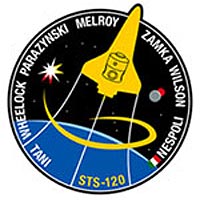Solar Micro Car Kit DIY STEM Kit
$9.99$4.95
Posted on: Oct 7, 2007

The seven STS-120 astronauts arrived at NASA's Kennedy Space Center in Florida on Sunday evening in their T-38 training jets, in advance of next week's launch dress rehearsal activities. During the week, the astronauts and ground crews are scheduled to participate in various simulated countdown activities and training exercises.
Over the past week, space shuttle Discovery rolled out from the Vehicle Assembly Building to Launch Pad 39A, where the payload for its mission was installed in the shuttle's cargo bay. The payload includes the Italian-built U.S. Harmony module, which will be delivered to the International Space Station.
Launch of Discovery is targeted for Oct. 23.
Mission Overview
STS-120 is the 23rd shuttle mission to the International Space Station, and will launch an Italian-built U.S. multi-port module for the station.
Retired Air Force Col. Pamela A. Melroy will command the STS-120 mission to take the Node 2 connecting module to the station. Melroy, a veteran shuttle pilot, is the second woman to command a shuttle. Marine Corps Col. George D. Zamka will serve as pilot. The flight's mission specialists will be Scott E. Parazynski, Army Col. Douglas H. Wheelock, Stephanie D. Wilson and Paolo A. Nespoli, a European Space Agency astronaut from Italy. Zamka, Wheelock and Nespoli will be making their first spaceflight.
Expedition 15/16 Flight Engineer Clayton Anderson will return to Earth from the space station aboard shuttle mission STS-120. That flight will carry his replacement, Daniel Tani, to the station. Tani will return on shuttle mission STS-122.
Harmony 2 Module
Think of the next component set for delivery to the International Space Station as an international crossroads in space. That's the major function of the Italian-built U.S. module that will be ferried to the station aboard space shuttle Discovery during mission STS-120. Harmony naming ceremony
The pressurized component was named 'Harmony' by U.S. students in a nationwide contest. 'This module will allow all international partner pieces of the station to connect together, so it's really wonderful that kids recognize that harmony is necessary for space cooperation,' said Bill Gerstenmaier, NASA's associate administrator for space operations, when the six winning schools who submitted the name were announced.
The module will be the connecting point between the U.S. Destiny lab, the European Space Agency's Columbus module and the Japanese Kibo module. Harmony's delivery to the station sets the stage for the following two space shuttle flights that will carry the Columbus and Kibo components to the station.
Those laboratory modules have been prepared side by side with Harmony in the high bay of the Space Station Processing Facility at NASA's Kennedy Space Center in Florida.
Harmony was delivered to Florida in 2003 aboard an Airbus Beluga aircraft. Harmony Node 2 arrives in Florida from Italy 'The first thing we did was a post-delivery inspection and checkout to make sure the ferry flight from Italy to Florida didn't cause any damage to the module,' said Glenn Chin, the payload mission manager for STS-120. Since then, a team of technicians has worked to prepare it for flight.
Weighing 31,500 pounds when loaded for flight, the 24-foot-long component will be parked in a temporary spot on the space station by the STS-120 crew, since the docked shuttle will be occupying Harmony's permanent spot. Later, the space station crew will relocate the module to its permanent location. Harmony will be the fourth named U.S. module on the station, taking its place with the Destiny laboratory, the Quest airlock and the Unity node.
'Harmony has been here with us for four years,' explained Chin. 'We've been working hard getting it ready for flight, and we've finally come to this stage of getting it ready to be put into the orbiter.'
Before each mission, the astronauts who will deliver the space station element spend time inside the Space Station Processing Facility. 'We had the crew here on about four different occasions' inspecting the module they will install on the orbiting outpost, said Chin.
While the excitement for the launch builds among those who have been working on the module since its arrival, there are also some mixed feelings about seeing it depart for its final destination.
'It's an exhilarating feeling of excitement and we're all anxious to see Harmony get to the pad,' said Chin. 'I've never been a mission manager for any other mission that was as challenging.' But even with all the excitement of the upcoming mission, he added that after working with the module for four years, 'we'll definitely miss Harmony.'
 'A hundred times every day I remind myself that my inner and outer life are based on the labors of other men, living and dead, and that I must exert myself in order to give in the same measure as I have received and am still receiving…'
'A hundred times every day I remind myself that my inner and outer life are based on the labors of other men, living and dead, and that I must exert myself in order to give in the same measure as I have received and am still receiving…'